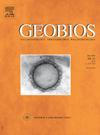德国巴伐利亚州哈默施米德中新世晚期人类遗址中的食肉动物群体
IF 1.6
4区 地球科学
Q2 PALEONTOLOGY
引用次数: 0
摘要
在中新世晚期的Hammerschmiede发现了种类繁多的脊椎动物,其中包括28种不同的食肉动物。主要层ham5 (11.62 Ma)和ham4 (11.44 Ma)分别寄生21种和17种食肉动物。本文通过行会结构分析,揭示其生态形态学作用。一项稀疏分析表明,如此高的食肉动物比例只能与La-Grive-Saint-Alban的裂隙填充物相媲美。报道了该地区若干属、种的最早和最后发生日期。关于每个科的物种数量和个体数量的地区概况在欧洲中新世地区中是独一无二的。根据它们的体重、运动模式和饮食偏好,这些发现的食肉动物被归为古生态类别。生态形态比较表明,大多数物种通过占据不同的生态位来减少竞争,但也存在生态重叠的情况。这表明哈默施米德的生态系统提供了多种多样的资源,使大量食肉动物得以生存。最后,两个主要层在食肉成分上表现出一定的差异,其中ham4以中小型鱼食性/多面性食肉动物为主,而ham5也包括大型硬食性/超食肉动物。本文章由计算机程序翻译,如有差异,请以英文原文为准。
The carnivoran guilds from the Late Miocene hominid locality of Hammerschmiede (Bavaria, Germany)
The Late Miocene locality of Hammerschmiede has yielded an astonishing diversity of vertebrates, including 28 different carnivoran species. The main layers HAM 5 (11.62 Ma) and HAM 4 (11.44 Ma) have been found to host 21 and 17 carnivoran species, respectively. Herein we perform a guild structure analysis aiming to unravel their ecomorphological role. A rarefaction analysis showed that such a high representation of carnivorans is comparable only to the fissure fillings of La-Grive-Saint-Alban. The First and Last Occurrence Dates of several genera and species are reported in the locality. The profile of the locality concerning the Numbers of Species and Individuals per family is unique among the Miocene localities of Europe. The discovered carnivorans were attributed to palaeoecological categories based on their body mass, locomotor pattern, and diet preferences. Ecomorphological comparison revealed that most species were able to reduce competition by occupying different ecological niches, but some cases of ecological overlap were found. This shows that the ecosystem of Hammerschmiede offered diverse resources that allowed the subsistence of a plethora of carnivorans. Finally, the two main layers exhibit some differences in their carnivoran components, with HAM 4 dominated by small-/medium-sized piscivores/generalist carnivores, whereas HAM 5 also includes large-sized durophagous/hypercarnivorous forms.
求助全文
通过发布文献求助,成功后即可免费获取论文全文。
去求助
来源期刊

Geobios
地学-古生物学
CiteScore
3.30
自引率
6.20%
发文量
28
审稿时长
6-12 weeks
期刊介绍:
Geobios publishes bimonthly in English original peer-reviewed articles of international interest in any area of paleontology, paleobiology, paleoecology, paleobiogeography, (bio)stratigraphy and biogeochemistry. All taxonomic groups are treated, including microfossils, invertebrates, plants, vertebrates and ichnofossils.
Geobios welcomes descriptive papers based on original material (e.g. large Systematic Paleontology works), as well as more analytically and/or methodologically oriented papers, provided they offer strong and significant biochronological/biostratigraphical, paleobiogeographical, paleobiological and/or phylogenetic new insights and perspectices. A high priority level is given to synchronic and/or diachronic studies based on multi- or inter-disciplinary approaches mixing various fields of Earth and Life Sciences. Works based on extant data are also considered, provided they offer significant insights into geological-time studies.
 求助内容:
求助内容: 应助结果提醒方式:
应助结果提醒方式:


